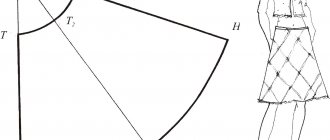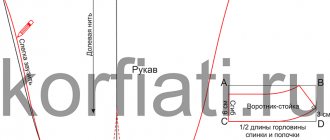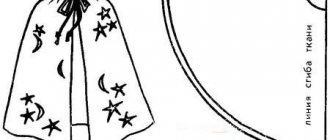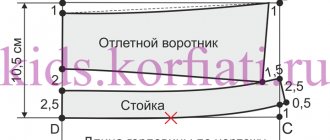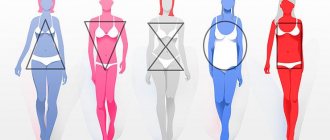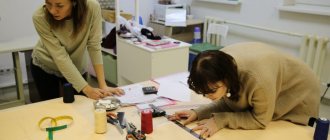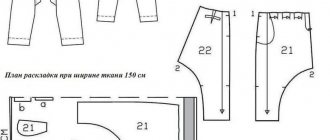Cutting a robe from a terry towel
There is a model that can be made in literally half an hour. It doesn't even need a pattern. In this case, a children's robe with a hood is made very simply: a neck is cut out in the middle of the towel. The hood is stitched to the neckline. The difficulty in making this model may lie in its cutting.
If the master has imagination and time, you can not just use a towel with a ready-made pattern. Using the appliqué technique, it is easy to create an exclusive and creative outfit, which may become your child’s favorite attire.
To decorate an outfit, you need to take fabric of a different color and even a different texture, for example, satin or silk. Applique details are cut out of it - in this version it is the body of a dolphin and its light belly.
You can purchase a second towel in a light blue color and a smaller size. An animal figure and a hood are cut out of it.
How to make a pattern
Let's consider the stages of completing the drawing required for cutting a children's robe.
Base for back and shelf
Help: the construction of the back and front is done in the same way at first, so you can draw the patterns for the front and back at once.
- On the paper along the edge we measure the DI and put points A and B. You need to measure so that there is at least 5-10 cm from the top edge of the paper to A.
- Divide the OB measurement by 4, then add 2 cm to the result.
- We measure the resulting number on paper from A and B perpendicular to the edge.
- We draw lines and put points B and D, respectively, we get segments AB and BG.
- We connect B and D using a ruler. You should get a rectangle.
- We add 0.5 cm to the DTS measurement and put the resulting value on the segment AB from A. Here we put point T1.
- The GP measure, having previously added 2 cm to it, must also be measured on the segment AB from A. This will be G1.
- From G1 and T1 we draw lines perpendicular to the segment AB to the segment VG and, accordingly, put G2 and T2.
- Then we divide the SH measurements by 2 and put the resulting result from G2 to G1G2 and call the point G3.
- Next, from G3 we draw a line parallel to segment AB to AB. We call the connection point the letter P.
- Divide the resulting segment G3P in half and place point P1.
- We connect P1 to G2 with a smooth concave line.
Further, the construction of patterns for the back and for the shelf differs.
Building the back
- To construct the back neckline, we will need an OSH measurement. We divide this measurement by 6 and then add 1 to the resulting number.
Important! Remember the obtained value, it will be useful to us when constructing the front neckline.
- We put the resulting value from A to AB and call it Ш1.
- From Ш1, perpendicular to line AB, measure 1-2 cm and place point Ш2.
Important! The size of the perpendicular depends on the child for whom the robe is sewn. The smaller the boy, the shorter this line.
- The segment Ш1Ш2 should not be inside the constructed rectangle ABCD, but on the outside.
- We connect Ш2 with A using a smooth concave arc.
- From P on segment PG3 we measure 1.5 cm and put P2.
- From Ш2 we draw a straight line through P2.
- Then we add 3 cm to the DP measurements and measure the resulting value on the line Ш2П2, starting from Ш2.
- We call the resulting point P3. P3 should be located after P2. We connect P3 to P1 with a smooth concave arc.
Building a shelf
- From T1 to A we set aside the road accident measurement, after adding 0.5 cm to it and call the point Ш3.
- If you measured everything correctly, then Ш3 will be located above A outside the rectangle ABCD.
- Next, from Ш3 we draw a parallel AB line.
- On this line we lay down the segment Ш3Ш4, equal to АШ1 (back pattern).
- From Ш3 down past A we measure 6 cm and place point Ш5.
- We connect Ш5 with Ш4 with a smooth curved arc.
- We draw a line further towards Ш4 along the segment Ш3Ш4. We also draw a line upward along the segment G3P. The lines must cross. We call the intersection point P4.
- From P4 down P4G3 we set aside 3.5 cm - it turns out P5.
- We connect Sh4 and P5 along a ruler and continue further from P5.
- On this line from Ш4 we lay a segment equal to Ш2П2 (back pattern) and put point P6.
- We connect P1 and P6 with a smooth curved arc.
Construction of the sleeve
- Add 3-4 cm to the OP measurement for a loose fit.
- Put the resulting value on paper, calling the segment P1P2.
- From P1 and P2, draw parallel lines down, equal to the DR measurement. Name the segments P1H1 and P2H2. The result will be a rectangle Р1Р2Н2Н1.
- We divide P1P2 and H1H2 in half and connect the division points to each other, calling them O1 and O2. You should get a segment O1O2 parallel to P1H1 and P2H2.
- From O1 down to O2 we measure the height of the sleeve rim - O3. We take this measurement from the back and front patterns. On the back, you need to measure the distance from P3 to the line G1G2, parallel to the segment PG3. And on the front, the distance P5 to the line G1G3, also parallel to the segment PG3.
- We add the resulting measurements together and then divide them in half. The resulting value will be the height of the sleeve edge.
- From O3 we draw a line parallel to the segment P1P2 to the right and left until it intersects with P1H1 and P2H2 - O4O5.
- We connect O1 with O4 and O5. Divide O1O4 in half - O6.
- From O6 towards P1 we set aside 1 cm and through this point we draw a curved arc from O1 to O4.
- Divide O1O5 into 4 equal parts and set aside 1 cm up from the first division point and 0.5 cm down from the third division point.
- Connect O1 to O5 through these points with a smooth convex-concave arc, intersecting the straight line O1O5 through the second point.
Construction of the hood
The hood pattern is based on head circumference + an increase of 4–8 cm and head height + an increase of 3–5 cm.
- You need to construct a rectangle using these measurements. In it, head circumference + increase will be horizontal lines, and head height + increase will be vertical lines.
- In the back right corner you need to put 2 cm down, in the bottom left corner up - 4 cm.
- Connect the resulting points with a smooth curved arc, touching the top and left sides of the rectangle.
- Measure the length of the necks on the front and back patterns, fold them and add 1 cm.
- Place the resulting value from a point on the left side of the rectangle, raised by 4 cm, to the bottom line of the rectangle.
- Connect these dots together.
- Also connect the newly obtained intersection points on the bottom side with the right side.
The pattern is ready! Have fun sewing your boy's robe!
What shoes to wear with a long down jacket
How to fold a scarf into a jacket pocket
Did you like it?
This is interesting: Pattern Children's scarf-hood (height 74-140)
Instructions for sewing a robe from a towel
- The main towel is folded in half crosswise.
- A neckline is cut out in the center.
- A hood and a dolphin figure are cut out of a smaller towel. The proposed pattern will help with this. A children's robe with a hood will turn out beautiful if the fabric for the applique is not very thick.
- An overlay for the abdomen is cut out of a light, smooth, plain fabric.
- The figure of the dolphin itself is sewn onto the chest so that the hood seems to serve as a continuation - the head of the animal.
- Be sure to process the edge of the hood. It is recommended to do this either with a hem or use bias tape.
- The hood is then sewn to the neckline. A bed stitch should be used.
- The eyes and mouth of a dolphin are embroidered on the hood.
- The light belly is located in the third layer. It is sewn on top of an applique that imitates the body of a dolphin.
- The edge of the neckline without a hood at the front of the product is treated with bias tape.
- If desired, the master can make a belt for the robe. Or you can sew large buttons on the sides and sew loops.
We sew a warm robe model from high-quality material without patterns
You will need:
- Large terry towel;
- A little fabric (about half a meter);
- A sweater or jacket that fits loosely on the child.
The production of a robe takes place in the following steps:
- Fold the towel in four layers;
- Place the sweater or jacket on the towel so that the central corner of the towel meets the middle of the neck;
- We retreat fifteen centimeters from the edges of the clothing and cut out the product, leaving the upper part uncut (shown in the figure);
- Next, you need to open the towel so that a two-layer letter T is formed;
- Cut the front panel in the middle;
- We make a triangular hood from two cut pieces of a towel;
- Sew the hood to the base of the robe;
- Sew the seams of the sleeves and sides of the robe;
- We make a belt from half a meter of loose fabric and use it to decorate the robe as desired.
- Before putting on, the robe must be washed and steamed well with a steam iron.
By following all the rules of cutting and sewing, making a children's robe is very simple. This process will not take much time and will bring a lot of pleasure from the result!
One-piece robe, flared at the bottom
If the span of the baby’s arms between the hands is not so large and fits into the width of the fabric, the following pattern will help to make such a model. The children's robe with a hood has no shoulder seams. Only the sidewalls are subject to stitching.
The model with contrasting lapels and large patch pockets looks very nice. But you can also sew a plain children’s robe with a hood. The pattern offered here can be used to sew garments of different sizes. It is only important to take into account the length of the product, the semi-circumference of the chest and the length of the sleeve.
Choosing a style and fabric for a children's robe for a girl
Let's look at several styles of dressing gowns for children: from the simplest, which can be sewn in just an hour, to complex ones. Everything will depend on your taste and the wishes of the child.
Fabrics can also be very different. Both terry, “frote” fabric, and ordinary terry towels are suitable. Some models will require a certain type of material.
How much terry do you need to buy? It depends on the size of the robe and measurements. It is best to first make a paper pattern and calculate the amount of material required based on the obtained dimensions. Let’s say the width of the fabric is 150 centimeters, you will need about 200 for the length of the robe and sleeves, about 15 should be left for hems, indentations and seams, and about 20-30 for the strap, if it is present.
This is interesting: Pattern Children's long-sleeve T-shirt (р 68-152)
Creating a pattern for a one-piece robe with a straight silhouette
A cool outfit with ears on the hood will delight both the baby and his loved ones. It looks like a fancy dress, so it gives only positive emotions. And it’s so easy to sew this children’s robe with a hood yourself. The pattern for making this outfit is quite simple.
- You need to draw a rectangle with one side equal to half the length of the span between the hands (size B). The second side can be arbitrary - this is the width of the sleeve folded in half at the shoulder (size D). The rectangle is positioned so that the longer side is horizontal.
- The second rectangle is built perpendicular to the first, placing them one on top of the other with the letter “G”. One side of the figure is equal to the length of the robe (size A), the other is half the chest circumference plus 2 centimeters.
- Using an arc, the lateral axillary part is formed at the site of the internal right angle.
- From the top of the connection of two right angles of both rectangles (at the upper left point), 6 cm is laid to the right and 3 cm down. These marks are smoothly connected with an arc. This is the back neckline.
- From the same top, 7 cm is laid down and connected with an arc to the point 6 cm. This will be the front neckline. In the drawing this line is highlighted in red.
- A scent is formed at the front of any size. It is highlighted in the drawing with a red line.
Usually craftsmen make their own patterns for children's dressing gowns. The hood can be a rectangle folded across, stitched together with a “bag”. But you can use the patterns suggested here. Ears are used as decoration.
Robe with a hood: choosing fabric
How to sew a robe with a hood with your own hands? This robe fits freely on the figure, so its cutting and sewing does not require darts or raised seams.
Pay special attention to the choice of fabric! A soft, warm fabric is best: cotton terry, flannel, cotton velvet, or cozy fleece. You can also use this pattern to sew a light summer robe from thin knitwear or silk. To accurately calculate the amount of fabric, draw all the details of the pattern and lay them out, taking into account allowances, on a flat surface. Measure the required size, taking into account the width of the fabric.
Depending on the type of fabric, select the method for processing seam allowances. The easiest way is to use an overlocker. Also, if the fabric is thin enough, you can finish the seam allowances with a double French seam, and if the fabric is too thick, you can use silky bias tape.
Our robe is tied with a belt, its length on average is equal to double the waist circumference plus 20-30 cm. We made one patch pocket on the robe, and you can add another one symmetrically or sew a robe without pockets.
So, let's sew a robe with a hood with your own hands!
Constructing a pattern
Take the following measurements
- Robe length
- The length of the sleeve
- Hip girth
- Bust
- Waist circumference
Front and back
You'll need a T-shirt or other piece of clothing that fits loosely. Copy the neckline and armhole, as well as the shoulder line, onto a piece of paper, first for the back, then for the front.
Place the desired length of the robe down from the top of the shoulder. The width of the front and back below the lower point of the armhole should be 1-2 cm greater than 1/4 of the chest circumference. Compare the circumferences of the chest, waist and hips. If the waist and hip circumferences are larger than the chest circumference, expand the width of the back and front by the required number of centimeters.
Add 7-10 cm in the center of the front and draw a new vertical line.
Sleeve
Measure the length of the armhole on the robe pattern. Calculate the height of the edging OO1 by dividing the length of the armhole by 3 and minus 5 cm, as well as the length of the auxiliary lines OP and OP1: half the length of the armhole according to the pattern.
From point O, set the height of the edge down and place point O1. Through O1 draw a horizontal line PP1.
From point O to the left and right, set aside the length of the auxiliary line of the sleeve edge OP and OP1. Divide the OP in half and set aside 1.5 cm from the division point upward. Divide OP1 into 3 equal parts and set it up from the first division point 1 cm down from the third division point - 0.5 cm. Draw a smooth line for the sleeve hem.
From point O, move the length of the sleeve down.
Hood
To create a hood pattern, take the following measurements:
- Head circumference
- Head height from shoulder to crown
Place point A in the lower left corner and draw a horizontal line from it to the right and a vertical line up.
Set aside 4 cm from point A and place point A1. To the right of A1, set aside 1 cm and place point A2.
Using the robe pattern, measure the length of the back and front neckline and add the resulting values.
From point A2, set aside the resulting amount + 3 cm in a straight line to a horizontal line from point A and place point C1.
From point A2, set aside the length of the back neck +1.5 cm and place point D. From it, set off the length of the dart at a right angle - 10 cm.
From point D on both sides, set aside 1.5 cm and connect these points with the height of the dart.
Smoothly bend section A2C1 upward.
From point A1, set the height of the head up according to the measurement + 3-5 cm (the more, the longer the edge of the hood will be) and place point B.
From point B, set aside 1/3 of the head circumference to the right according to the measurement + 4-9 cm (the more, the wider the hood will be).
From point C downwards, set aside 1-2 cm and through this point form the upper edge of the hood, as shown in the diagram.
Also connect this point to point C1 with a smooth concave line.
Uncover
The allowance for the bottom of the robe and sleeves is 3-4 cm, for the remaining seams - 1 cm.
- Front part - 2 pieces, mirrored
- Back part - 1 piece with a fold in the center or 2 mirrored
- Hood — 2 pieces, mirrored
- Belt - a strip 6 cm wide and the required length
- Free-form pocket with 3 cm top allowance
- The facing of the robe is 3 cm wide and a length equal to double the length of the front plus double the length of the hood plus 5 cm. If it is not possible to cut out a single facing, sew several strips into one.
- Two belt loops 4x6 cm
Progress
Fold the waistband piece in half lengthwise, right sides facing in. Sew along all sides, leaving an opening of about 5cm along the long side of the waistband. Turn the entire belt through the hole.
Close the open hole by hand using a blind stitch.
Fold the top edge of the pocket 5 mm, then 2 cm to the wrong side and baste. Stitch.
Fold the edges of the pocket 5 mm inward and baste. Baste onto the front half at the desired height.
Sew the pocket with a double stitch.
Sew the hood, placing the pieces right sides together. Process the allowances.
Sew the shoulder seams, placing the back and front pieces right sides together. Process the allowances.
Sew the hood to the neck line. Wrap the seam allowance with bias tape from a matching fabric or scrap of the main fabric and baste. Stitch.
Sew the sleeves into the armholes, matching the top of the sleeve cap and the shoulder seam. Process the allowances
Sew the side seam of the robe and the side seam of the sleeve, aligning the armhole points. Process the allowances.
Fold the bottom of the robe twice and stitch. Sew the facing along the entire edge of the front halves of the robe and hood. Fold the edge of the facing, covering the folded bottom of the robe, and baste.
Fold the edge along the entire length of the facing, fold it in half and baste the seam allowances onto the edge.
Sew along the edge of the facing.
Fold the bottom edge of the sleeve over twice and stitch.
Fold the belt loop pieces inward toward the middle and in half again. Sew the belt loops to the side seams at waist level, folding the edges at the top and bottom.
The robe with a hood is ready!
This is interesting: Pattern Children's robe (p 86-134)
Robe with yoke and sewn-in sleeves
Older girls already want to emphasize their femininity. Therefore, a model with a yoke will suit them. The shelves are slightly seated during stitching, which creates the effect of some pomp in the chest area.
This model requires some skill. But with enough care and attention, you can get a very decent children's bathrobe with a hood. The back pattern is placed on the fold of the folded fabric.
The shelves are also cut out after the fabric is folded with the right side inward. But in this case you should get 2 parts. The same goes for cutting sleeves and yokes.
How to make a children's terry robe with a hood: dimensions and corresponding parameters
In this case, only Russian sizes are considered. To these parameters, when making patterns, you need to add one and a half centimeters as an allowance.
- Size eighty-six corresponds to a child aged one and a half years. Parameters (minimum):
chest circumference - fifty-two;
waist circumference - forty-nine;
hip circumference – fifty-two.
- Size ninety-eight corresponds to a child aged three years. Minimum parameters: chest circumference - fifty-four;
waist circumference - fifty-one;
hip circumference – fifty-five.
- Size one hundred and four corresponds to a child aged four years. Minimum parameters:
chest circumference - fifty-five;
waist circumference - fifty-two;
hip circumference – fifty-seven.
- Size one hundred and ten corresponds to a child aged five years. Minimum parameters:
chest circumference - fifty-six;
waist circumference - fifty-three;
hip circumference - fifty-nine;
- Size one hundred and sixteen corresponds to a child aged six years. Minimum parameters:
chest circumference - fifty-seven;
waist circumference - fifty-four;
hip coverage - sixty-one;
- Size one hundred and twenty-two corresponds to a child aged seven years. Minimum parameters:
chest circumference - fifty-eight;
waist circumference - fifty-five;
hip circumference – sixty-three.
- Size one hundred and twenty-eight corresponds to a child aged eight years. Minimum parameters:
chest circumference - sixty-one;
waist circumference - fifty-seven;
hip circumference – sixty-six.
- Size one hundred and forty corresponds to a child aged ten years. Minimum parameters:
chest girth – sixty-seven;
waist circumference - fifty-nine;
hip circumference – seventy-two.
To sew a terry robe for a girl you will need:
- Finished pattern on cardboard (in this case, size one hundred and fourth);
- Terry cloth (or large terry towel);
- Sewing machine;
- Scissors;
- Iron;
- Chalk.
First you need to do the cutting. To do this, lay out all parts of the pattern on the fabric and outline it with chalk. After which, they are carefully cut out using scissors. On finished parts, it is necessary to retreat an allowance of one and a half centimeters on all sides of the product and outline the resulting internal contour with chalk.
As a result, you should get the following number of parts:
- One back piece (with fold);
- Two front parts;
- Two hood parts;
- Two sleeve parts;
- One belt piece.
Sewing is performed in the following steps:
- Belt. Fold the piece in half and stitch it using a sewing machine on three sides, leaving a small hole in the third side. It is necessary to sew from the wrong side. Through the space left, turn the product right side out. We manually sew up the hole and steam the finished belt with an iron.
- We place the parts of the front and back on top of each other and join them at the shoulders. Double stitch the shoulders and side seams. All resulting seams are carefully steamed with an iron.
- Next, you need to attach the sleeves, sew them at the joints and steam them well using an iron.
- If desired, you can attach several loops under the belt at the waist line.
- We sew the hood and attach the finished product to the robe. The seams are also steamed with an iron.
Before wearing, the robe must be washed and ironed well with a steam iron.
This is interesting: Pattern Children's one-piece top (р 74-128)
